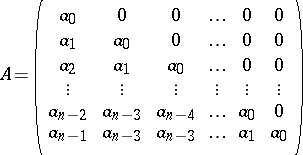Difference between revisions of "Carathéodory-Schur extension problem"
Ulf Rehmann (talk | contribs) m (moved Carathéodory–Schur extension problem to Caratheodory-Schur extension problem: ascii title) |
Ulf Rehmann (talk | contribs) m (moved Caratheodory-Schur extension problem to Carathéodory-Schur extension problem: accented title) |
(No difference)
| |
Revision as of 07:54, 26 March 2012
Let  be a given polynomial. The Carathéodory–Schur extension problem is to find (if possible) an analytic function
be a given polynomial. The Carathéodory–Schur extension problem is to find (if possible) an analytic function  on the open unit disc
on the open unit disc  such that
such that  has a Taylor expansion (cf. Taylor series) of the form
has a Taylor expansion (cf. Taylor series) of the form
 | (a1) |
and  is uniformly bounded by one on
is uniformly bounded by one on  . In other words,
. In other words,  is an
is an  -function with
-function with  of which the first
of which the first  Taylor coefficients are prescribed. The problem is solvable if and only if the lower-triangular Toeplitz matrix
Taylor coefficients are prescribed. The problem is solvable if and only if the lower-triangular Toeplitz matrix
 |
has operator norm at most one. If  , the solution is unique. If
, the solution is unique. If  , then the number of solutions is infinite, and the set of solutions can be parametrized by a fractional-linear mapping. The necessary and sufficient conditions for the existence of a solution can also be expressed in terms of the so-called Schur numbers, which can be constructed step-by-step from the given coefficients
, then the number of solutions is infinite, and the set of solutions can be parametrized by a fractional-linear mapping. The necessary and sufficient conditions for the existence of a solution can also be expressed in terms of the so-called Schur numbers, which can be constructed step-by-step from the given coefficients  (cf. also Carathéodory interpolation). This latter approach, invented originally by I. Schur [a6], [a7], in the beginning of the 19th century, includes recursive methods to obtain the set of all solutions. These recursive methods play an important role in modern operator theory, electrical engineering and geophysics (see [a3], [a4], [a5]). A detailed account of the Carathéodory–Schur problem and its solution may be found in [a3], Chapt. 1.
(cf. also Carathéodory interpolation). This latter approach, invented originally by I. Schur [a6], [a7], in the beginning of the 19th century, includes recursive methods to obtain the set of all solutions. These recursive methods play an important role in modern operator theory, electrical engineering and geophysics (see [a3], [a4], [a5]). A detailed account of the Carathéodory–Schur problem and its solution may be found in [a3], Chapt. 1.
By multiplying both sides of (a1) by  , one sees that the Carathéodory–Schur extension problem for the polynomial
, one sees that the Carathéodory–Schur extension problem for the polynomial  is equivalent to the Nehari extension problem for the sequence
is equivalent to the Nehari extension problem for the sequence  . The problem may also be seen as a Nevanlinna–Pick-type interpolation problem, where one seeks
. The problem may also be seen as a Nevanlinna–Pick-type interpolation problem, where one seeks  of
of  -norm at most one such that the function and its derivatives up to order
-norm at most one such that the function and its derivatives up to order  have prescribed values at zero (cf. also Nevanlinna–Pick interpolation). The Carathéodory–Schur extension problem has natural generalizations for matrix-valued and operator-valued polynomials (see [a2]). The problem has also a non-stationary variant, in which the role of the polynomial is taken over by a lower-triangular band matrix which has to be completed to a full lower-triangular matrix of operator norm at most one. For this non-stationary variant there is a natural analogue of the Schur numbers, namely the choice sequences, which determine the set of solutions (cf. [a1]).
have prescribed values at zero (cf. also Nevanlinna–Pick interpolation). The Carathéodory–Schur extension problem has natural generalizations for matrix-valued and operator-valued polynomials (see [a2]). The problem has also a non-stationary variant, in which the role of the polynomial is taken over by a lower-triangular band matrix which has to be completed to a full lower-triangular matrix of operator norm at most one. For this non-stationary variant there is a natural analogue of the Schur numbers, namely the choice sequences, which determine the set of solutions (cf. [a1]).
References
| [a1] | T. Constantinescu, "Schur parameters, factorization and dilation problems" , Operator Theory: Advances and Applications , 2 , Birkhäuser (1996) |
| [a2] | V.K. Dubovoj, B. Fritzsche, B. Kirstein, "Matricial version of the classical Schur problem" , Teubner (1992) |
| [a3] | C. Foias, A.E. Frazho, "The commutant lifting approach to interpolation problems" , Operator Theory: Advances and Applications , 44 , Birkhäuser (1990) |
| [a4] | "Schur methods in operator theory and signal processing" I. Gohberg (ed.) , Operator Theory: Advances and Applications , 18 , Birkhäuser (1986) |
| [a5] | T. Kailath, A.H. Sayed, "Displacement structure: theory and applications" SIAM Review , 37 (1995) pp. 297–386 |
| [a6] | I. Schur, "On power series which are bounded in the interior of the unit circle" I. Gohberg (ed.) , Methods in Operator Theory and Signal Processing , Operator Theory: Advances and Applications , 18 (1986) pp. 31–59 (Original (in German): J. Reine Angew. Math. 147 (1917), 205–232) |
| [a7] | I. Schur, "On power series which are bounded in the interior of the unit circle. II" I. Gohberg (ed.) , Methods in Operator Theory and Signal Processing , Operator Theory: Advances and Applications , 18 (1986) pp. 68–88 (Original (in German): J. Reine Angew. Math. 184 (1918), 122–145) |
Carathéodory-Schur extension problem. Encyclopedia of Mathematics. URL: http://encyclopediaofmath.org/index.php?title=Carath%C3%A9odory-Schur_extension_problem&oldid=23224